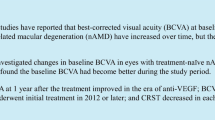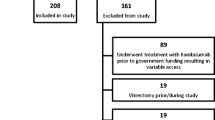Abstract
Purpose
The aim of this work is to investigate the characteristics of eyes failing to maintain visual acuity (VA) receiving variable dosing ranibizumab for neovascular age-related macular degeneration (nAMD) after three initial loading doses.
Methods
A consecutive series of patients with nAMD, who, after three loading doses of intravitreal ranibizumab (0.5 mg each), were re-treated for fluid seen on optical coherence tomography. After exclusion of eyes with previous treatment, follow-up less than 12 months, or missed visits, 99 patients were included in the analysis. The influence of baseline characteristics, initial VA response, and central retinal thickness (CRT) fluctuations on the VA stability from month 3 to month 24 were analyzed using subgroups and multiple regression analyses.
Results
Mean follow-up duration was 21.3 months (range 12–40 months, 32 patients followed-up for ≥24 months). Secondary loss of VA (loss of five letters or more) after month 3 was seen in 30 patients (mean VA improvement from baseline +5.8 letters at month 3, mean loss from baseline –5.3 letters at month 12 and –9.7 at final visit up to month 24), while 69 patients maintained vision (mean gain +8.9 letters at month 3, +10.4 letters at month 12, and +12.8 letters at final visit up to month 24). Secondary loss of VA was associated with the presence of pigment epithelial detachment (PED) at baseline (p 0.01), but not with baseline fibrosis/atrophy/hemorrhage, CRT fluctuations, or initial VA response. Chart analysis revealed additional individual explanations for the secondary loss of VA, including retinal pigment epithelial tears, progressive fibrosis, and atrophy.
Conclusions
Tissue damage due to degeneration of PED, retinal pigment epithelial tears, progressive fibrosis, progressive atrophy, or massive hemorrhage, appears to be relevant in causing secondary loss of VA despite vascular endothelial growth factor suppression. PED at baseline may represent a risk factor.



Similar content being viewed by others
References
Brown DM, Kaiser PK, Michels M, Soubrane G, Heier JS, Kim RY, Sy JP, Schneider S (2006) Ranibizumab versus verteporfin for neovascular age-related macular degeneration. N Engl J Med 355:1432–1444
Brown DM, Michels M, Kaiser PK, Heier JS, Sy JP, Ianchulev T (2009) Ranibizumab versus verteporfin photodynamic therapy for neovascular age-related macular degeneration: two-year results of the ANCHOR study. Ophthalmology 116:57–65
Rosenfeld PJ, Brown DM, Heier JS, Boyer DS, Kaiser PK, Chung CY, Kim RY (2006) Ranibizumab for neovascular age-related macular degeneration. N Engl J Med 355:1419–1431
Abraham P, Yue H, Wilson L (2010) Randomized, double-masked, sham-controlled trial of ranibizumab for neovascular age-related macular degeneration: PIER study year 2. Am J Ophthalmol 150:315–324
Regillo CD, Brown DM, Abraham P, Yue H, Ianchulev T, Schneider S, Shams N (2008) Randomized, double-masked, sham-controlled trial of ranibizumab for neovascular age-related macular degeneration: PIER Study year 1. Am J Ophthalmol 145:239–248
Mitchell P, Korobelnik JF, Lanzetta P, Holz FG, Prunte C, Schmidt-Erfurth U, Tano Y, Wolf S (2010) Ranibizumab (Lucentis) in neovascular age-related macular degeneration: evidence from clinical trials. Br J Ophthalmol 94:2–13
Schmidt-Erfurth U, Eldem B, Guymer R, Korobelnik JF, Schlingemann RO, Axer-Siegel R, Wiedemann P, Simader C, Gekkieva M, Weichselberger A (2011) Efficacy and safety of monthly versus quarterly ranibizumab treatment in neovascular age-related macular degeneration The EXCITE Study. Ophthalmology 118:831–839
Fung AE, Lalwani GA, Rosenfeld PJ, Dubovy SR, Michels S, Feuer WJ, Puliafito CA, Davis JL, Flynn HW Jr, Esquiabro M (2007) An optical coherence tomography-guided, variable dosing regimen with intravitreal ranibizumab (Lucentis) for neovascular age-related macular degeneration. Am J Ophthalmol 143:566–583
Boyer DS, Antoszyk AN, Awh CC, Bhisitkul RB, Shapiro H, Acharya NR (2007) Subgroup analysis of the MARINA study of ranibizumab in neovascular age-related macular degeneration. Ophthalmology 114:246–252
Kaiser PK, Brown DM, Zhang K, Hudson HL, Holz FG, Shapiro H, Schneider S, Acharya NR (2007) Ranibizumab for predominantly classic neovascular age-related macular degeneration: subgroup analysis of first-year ANCHOR results. Am J Ophthalmol 144:850–857
Menghini M, Kurz-Levin MM, Amstutz C, Michels S, Windisch R, Barthelmes D, Sutter FK (2010) Response to ranibizumab therapy in neovascular. Klin Monbl Augenheilkd 227:244–248
Rosenfeld PJ, Shapiro H, Tuomi L, Webster M, Elledge J, Blodi B (2011) Characteristics of patients losing vision after 2 years of monthly dosing in the phase III ranibizumab clinical trials. Ophthalmology 118:523–530
Tao Y, Jonas JB (2010) Intravitreal bevacizumab for exudative age-related macular degeneration: effect on different subfoveal membranes. Retina 30:1426–1431
Chan CK, Meyer CH, Gross JG, Abraham P, Nuthi AS, Kokame GT, Lin SG, Rauser ME, Kaiser PK (2007) Retinal pigment epithelial tears after intravitreal bevacizumab injection for neovascular age-related macular degeneration. Retina 27:541–551
Chan CK, Abraham P, Meyer CH, Kokame GT, Kaiser PK, Rauser ME, Gross JG, Nuthi AS, Lin SG, Daher NS (2010) Optical coherence tomography-measured pigment epithelial detachment height as a predictor for retinal pigment epithelial tears associated with intravitreal bevacizumab injections. Retina 30:203–211
Kook D, Wolf A, Neubauer AS, Haritoglou C, Priglinger SG, Kampik A, Ulbig MW (2008) Retinal pigment epithelial tears after intravitreal injection of bevacizumab for AMD. Frequency and progress. Ophthalmologe 105:158–164
Weinberger AW, Thiel M, Mohammadi B, Theofylaktopoulos I, Thumann G, Walter P (2007) Retinal pigment epithelium tears after intravitreal bevacizumab in pigment epithelium detachment. Am J Ophthalmol 144:294–296
Arias L, Caminal JM, Rubio M, Pujol O, Arruga J (2007) Retinal pigment epithelial tears after intravitreal bevacizumab injection for predominantly classic choroidal neovascularization. Eur J Ophthalmol 17:992–995
Konstantinidis L, Ambresin A, Zografos L, Mantel I (2010) Retinal pigment epithelium tears after intravitreal injection of ranibizumab for predominantly classic neovascular membranes secondary to age-related macular degeneration. Acta Ophthalmol 88:736–741
Gerding H, Loukopoulos V, Riese J, Herner L, Timmermann M (2011) Results of flexible ranibizumab treatment in age-related macular degeneration and search of parameters with impact on outcome. Graefes Arch Clin Exp Ophthalmol 249:653–662
Heimes B, Lommatzsch A, Zeimer M, Gutfleisch M, Spital G, Dietzel M, Pauleikhoff D (2011) Long-term visual course after anti-VEGF therapy for exudative AMD in clinical practice evaluation of the German reinjection scheme. Graefes Arch Clin Exp Ophthalmol 249:639–644
Rothenbuehler SP, Waeber D, Brinkmann CK, Worl S, Wolf-Schnurrbusch UEK (2009) Effects of ranibizumab in patients with subfoveal choroidal neovascularization attributable to age-related macular degeneration. Am J Ophthalmol 147:831–837
Querques G, Azrya S, Martinelli D, Berboucha E, Feldman A, Pece A, Coscas G, Soubrane G, Souied E (2010) Ranibizumab for exudative age-related macular degeneration: 24-month outcomes from a single-centre institutional setting. Br J Ophthalmol 94:292–296
Boyer DS, Heier JS, Brown DM, Francom SF, Ianchulev T, Rubio RG (2009) A Phase IIIb study to evaluate the safety of ranibizumab in subjects with neovascular age-related macular degeneration. Ophthalmology 116:1731–1739
Cohen SY, Dubois L, Tadayoni R, Fajnkuchen F, Nghiem-Buffet S, Ahaye-Mazza C, Guiberteau B, Quentel G (2009) Results of one-year's treatment with ranibizumab for exudative age-related macular degeneration in a clinical setting. Am J Ophthalmol 148:409–413
Dadgostar H, Ventura AA, Chung JY, Sharma S, Kaiser PK (2009) Evaluation of injection frequency and visual acuity outcomes for ranibizumab monotherapy in exudative age-related macular degeneration. Ophthalmology 116:1740–1747
Mantel I, Zografos L, Ambresin A (2008) Early clinical experience with ranibizumab for occult and minimally classic neovascular membranes in age-related macular degeneration. Ophthalmologica 222:321–323
Giani A, Cigada M, Esmaili DD, Salvetti P, Luccarelli S, Marziani E, Luiselli C, Sabella P, Cereda M, Eandi C, Staurenghi G (2010) Artifacts in automatic retinal segmentation using different optical coherence tomography instruments. Retina 30:607–616
Gerding H (2010) Behandlung der feuchten altersabhangigen Makuladegeneration mit weniger als 12 Ranibizumab-Injektionen pro Jahr. Klin Monbl Augenheilkd 227:294–297
Funding
None.
Financial disclosure
None.
Author information
Authors and Affiliations
Corresponding author
Electronic supplementary material
Below is the link to the electronic supplementary material.
ESM 1
(DOC 26 kb)
Rights and permissions
About this article
Cite this article
Mariani, A., Deli, A., Ambresin, A. et al. Characteristics of eyes with secondary loss of visual acuity receiving variable dosing ranibizumab for neovascular age-related macular degeneration. Graefes Arch Clin Exp Ophthalmol 249, 1635–1642 (2011). https://doi.org/10.1007/s00417-011-1734-5
Received:
Revised:
Accepted:
Published:
Issue Date:
DOI: https://doi.org/10.1007/s00417-011-1734-5




